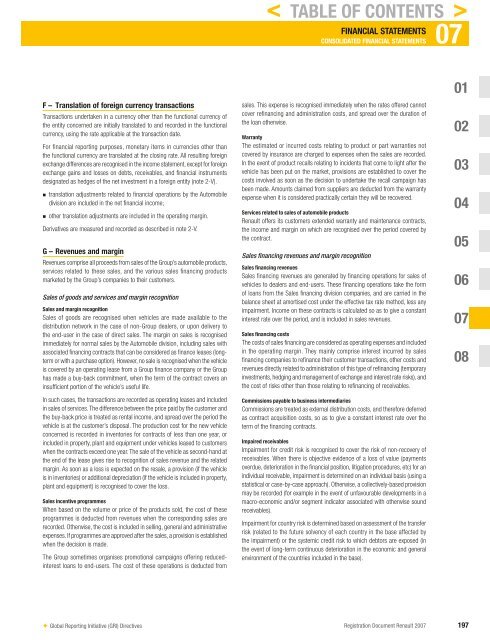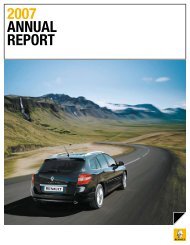2007 Interactive Registration Document - Renault
2007 Interactive Registration Document - Renault
2007 Interactive Registration Document - Renault
You also want an ePaper? Increase the reach of your titles
YUMPU automatically turns print PDFs into web optimized ePapers that Google loves.
F – Translation of foreign currency transactions<br />
Transactions undertaken in a currency other than the functional currency of<br />
the entity concerned are initially translated to and recorded in the functional<br />
currency, using the rate applicable at the transaction date.<br />
For fi nancial reporting purposes, monetary items in currencies other than<br />
the functional currency are translated at the closing rate. All resulting foreign<br />
exchange differences are recognised in the income statement, except for foreign<br />
exchange gains and losses on debts, receivables, and fi nancial instruments<br />
designated as hedges of the net investment in a foreign entity (note 2-V).<br />
n<br />
n<br />
translation adjustments related to fi nancial operations by the Automobile<br />
division are included in the net fi nancial income;<br />
other translation adjustments are included in the operating margin.<br />
Derivatives are measured and recorded as described in note 2-V.<br />
G – Revenues and margin<br />
Revenues comprise all proceeds from sales of the Group’s automobile products,<br />
services related to these sales, and the various sales fi nancing products<br />
marketed by the Group’s companies to their customers.<br />
Sales of goods and services and margin recognition<br />
Sales and margin recognition<br />
Sales of goods are recognised when vehicles are made available to the<br />
distribution network in the case of non-Group dealers, or upon delivery to<br />
the end-user in the case of direct sales. The margin on sales is recognised<br />
immediately for normal sales by the Automobile division, including sales with<br />
associated fi nancing contracts that can be considered as fi nance leases (longterm<br />
or with a purchase option). However, no sale is recognised when the vehicle<br />
is covered by an operating lease from a Group fi nance company or the Group<br />
has made a buy-back commitment, when the term of the contract covers an<br />
insuffi cient portion of the vehicle’s useful life.<br />
In such cases, the transactions are recorded as operating leases and included<br />
in sales of services. The difference between the price paid by the customer and<br />
the buy-back price is treated as rental income, and spread over the period the<br />
vehicle is at the customer’s disposal. The production cost for the new vehicle<br />
concerned is recorded in inventories for contracts of less than one year, or<br />
included in property, plant and equipment under vehicles leased to customers<br />
when the contracts exceed one year. The sale of the vehicle as second-hand at<br />
the end of the lease gives rise to recognition of sales revenue and the related<br />
margin. As soon as a loss is expected on the resale, a provision (if the vehicle<br />
is in inventories) or additional depreciation (if the vehicle is included in property,<br />
plant and equipment) is recognised to cover the loss.<br />
Sales incentive programmes<br />
When based on the volume or price of the products sold, the cost of these<br />
programmes is deducted from revenues when the corresponding sales are<br />
recorded. Otherwise, the cost is included in selling, general and administrative<br />
expenses. If programmes are approved after the sales, a provision is established<br />
when the decision is made.<br />
The Group sometimes organises promotional campaigns offering reducedinterest<br />
loans to end-users. The cost of these operations is deducted from<br />
✦ Global Reporting Initiative (GRI) Directives<br />
< TABLE OF CONTENTS ><br />
FINANCIAL STATEMENTS 07<br />
CONSOLIDATED FINANCIAL STATEMENTS<br />
sales. This expense is recognised immediately when the rates offered cannot<br />
cover refi nancing and administration costs, and spread over the duration of<br />
the loan otherwise.<br />
Warranty<br />
The estimated or incurred costs relating to product or part warranties not<br />
covered by insurance are charged to expenses when the sales are recorded.<br />
In the event of product recalls relating to incidents that come to light after the<br />
vehicle has been put on the market, provisions are established to cover the<br />
costs involved as soon as the decision to undertake the recall campaign has<br />
been made. Amounts claimed from suppliers are deducted from the warranty<br />
expense when it is considered practically certain they will be recovered.<br />
Services related to sales of automobile products<br />
<strong>Renault</strong> offers its customers extended warranty and maintenance contracts,<br />
the income and margin on which are recognised over the period covered by<br />
the contract.<br />
Sales financing revenues and margin recognition<br />
Sales financing revenues<br />
Sales fi nancing revenues are generated by fi nancing operations for sales of<br />
vehicles to dealers and end-users. These fi nancing operations take the form<br />
of loans from the Sales fi nancing division companies, and are carried in the<br />
balance sheet at amortised cost under the effective tax rate method, less any<br />
impairment. Income on these contracts is calculated so as to give a constant<br />
interest rate over the period, and is included in sales revenues.<br />
Sales financing costs<br />
The costs of sales fi nancing are considered as operating expenses and included<br />
in the operating margin. They mainly comprise interest incurred by sales<br />
fi nancing companies to refi nance their customer transactions, other costs and<br />
revenues directly related to administration of this type of refi nancing (temporary<br />
investments, hedging and management of exchange and interest rate risks), and<br />
the cost of risks other than those relating to refi nancing of receivables.<br />
Commissions payable to business intermediaries<br />
Commissions are treated as external distribution costs, and therefore deferred<br />
as contract acquisition costs, so as to give a constant interest rate over the<br />
term of the fi nancing contracts.<br />
Impaired receivables<br />
Impairment for credit risk is recognised to cover the risk of non-recovery of<br />
receivables. When there is objective evidence of a loss of value (payments<br />
overdue, deterioration in the fi nancial position, litigation procedures, etc) for an<br />
individual receivable, impairment is determined on an individual basis (using a<br />
statistical or case-by-case approach). Otherwise, a collectively-based provision<br />
may be recorded (for example in the event of unfavourable developments in a<br />
macro-economic and/or segment indicator associated with otherwise sound<br />
receivables).<br />
Impairment for country risk is determined based on assessment of the transfer<br />
risk (related to the future solvency of each country in the base affected by<br />
the impairment) or the systemic credit risk to which debtors are exposed (in<br />
the event of long-term continuous deterioration in the economic and general<br />
environment of the countries included in the base).<br />
01<br />
02<br />
03<br />
04<br />
05<br />
06<br />
07<br />
08<br />
<strong>Registration</strong> <strong>Document</strong> <strong>Renault</strong> <strong>2007</strong> 197




